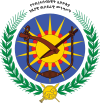Government of the Derg
This article may require copy editing for grammar and general style. (May 2024) |
| Unitary Marxist-Leninist one-party provisional government under a military junta (1974–1987) Unitary Marxist-Leninist one-party socialist republic (1987–1991) | |
 Emblem of the Provisional Military Administrative Council (Derg) | |
| Formation | 12 September 1974 |
|---|---|
| Extinction | 28 May 1991 |
| Country |
|
| Legislative branch | |
| Legislature |
|
| Chair |
|
| Meeting place | National Palace, Addis Ababa, Ethiopia |
| Executive branch | |
| Mengistu Haile Mariam (1987–1991) | President and General Secretary |
| Fikre Selassie Wogderess (1987–1989) | Prime Minister |
| Haile Yimenu (1989–1991) | Prime Minister |
| Tesfaye Dinka (1991) | Prime Minister |
The government of the Derg consisted of Unitary Marxist–Leninist one-party system with communist and later socialist ideology. Opposing feudal system of Ethiopia, the Derg abolished land tenure in March 1975 and began sweeping land reform under Land Reform Proclamation. All means of goods have been therefore nationalized by the regime including housing, land, farms, and industry.
The term "Ethiopian socialism" embodying slogan "self-reliance", the dignity of labor, and "the supremacy of the common good" allowed peasants to freely distribute their land and form peasant associations. In 1984, the Derg formed Workers Party of Ethiopia (WPE) headed by Mengistu Haile Mariam and formalized the establishment of the People Democratic Republic of Ethiopia in 1986.
The Derg devoted itself aligning Eastern bloc (Soviet Union, Cuba, and Eastern European states) from the beginning with Soviet Union considered "natural ally to Ethiopia". However, the fall of communism in East Europe in 1989 contributed decline of socialism and loss of connection with the Soviet Union—by March 1990–socialism was waned away and the Derg renamed its ruling party as the Ethiopian Democratic Party (EDP), with membership open to non-Marxists.
Provisional Military Government of Socialist Ethiopia
[edit]Upon deposing Emperor Haile Selassie on 12 September 1974 and seizing its power, the Derg adopted title such as "committee", consisting provisional administrative council of soldiers which has socialist and military ideology.[1][2] Initially, the Derg was popular after they came to power with slogan "Ethiopia First", "Land to the peasants", and "Democracy and Equality to all".[3] All means of production were nationalized, including land, housing, farms, and industry. In January and February 1975, the regime extended its nationalization efforts to encompass all banks and insurance firms, as well as taking control of nearly every major company.[4]
The Derg promoted "Ethiopian socialism", embodying slogans such as "self-reliance", the dignity of labor, and "the supremacy of the common good".[4] On 4 March 1975, the Derg as a council proclaimed sweeping land reforms and drafted Land Reform Proclamation, aiming to eliminate complex land tenure system. This phenomenon could allow the peasants to take over the land and encourage themselves into "peasant associations", while the government, partly for ideological reasons, did not control the process. The peasants preferred to either redistribute land among themselves or engage in collective forms of land cultivation. By September 1977, the number of associations had increased to 24,700, with membership of over 6.7 million persons according to Ministry of Agriculture and Settlements handout.[5]

The Derg had initially approached the Western Bloc, including the United States and Western European countries, but shifted towards the Eastern Bloc (Soviet Union and Warsaw Pact) due to the lack of US support for Ethiopia and the recurring human rights violations in the country. The foreign policy of the military regime was characterized by a focus on military defense capabilities against the "historical enemies of Ethiopia." Influenced by Marxist-Leninist ideology and concepts of society, the Derg's foreign policy shared similarities, particularly in its strong commitment to the Soviet Union, which was viewed as "the natural ally of Ethiopia."[6]
In 1984, the Derg junta transformed itself into Workers Party of Ethiopia (WPE) and formalized its rule by establishing the People's Democratic Republic of Ethiopia (PDRE) in 1986.[7]
People's Democratic Republic of Ethiopia
[edit]
In September 1987, Mengistu Haile Mariam declared Ethiopia as the Ethiopian People's Democratic Republic, and the Derg transformed into the Ethiopian Workers Party (EWP). After a failed coup against Mengistu in 1989, socialism was abandoned in 1990 following the collapse of communism in Eastern Europe. Mengistu's government faced challenges such as losing access to affordable fuel and arms supply. As a result, free-market policies were implemented, allowing opposition groups to join a unity party. By March 1990, socialism had completely dissipated, leading to the renaming of the ruling party from Workers Party Ethiopia (WPE) to the Ethiopian Democratic Unity Party (EDUP), with membership open to non-Marxists.[8]
References
[edit]- ^ "The Derg Period – When To Visit Ethiopia". OVERLAND Ethiopia Tours. Retrieved 17 September 2022.
- ^ Henze, Paul B. (1992). The Defeat of the Derg and the Establishment of New Governments in Ethiopia and Eritrea. Rand.
- ^ "The Ethiopian Revolution, The Derg, Civil War and Famine". www.ethiopiantreasures.co.uk. Retrieved 17 September 2022.
- ^ a b "1975–1991 – The Dergue". www.globalsecurity.org. Retrieved 17 September 2022.
- ^ Ottaway, Marina (1977). "Land Reform in Ethiopia 1974–1977". African Studies Review. 20 (3): 79–90. doi:10.2307/523755. ISSN 0002-0206. JSTOR 523755. S2CID 145202228.
- ^ "Ethiopian Foreign Policy Under Military and EPRDF Regimes: Changes and Continuities". 17 September 2022.
- ^ Henze, Paul B. (1990). "The Ethiopian Revolution: Mythology and History". Northeast African Studies. 12 (2/3): 1–17. ISSN 0740-9133. JSTOR 43660311.
- ^ "ETHIOPIA COUNTRY ASSESSMENT" (PDF). 17 September 2022. p. 8.
